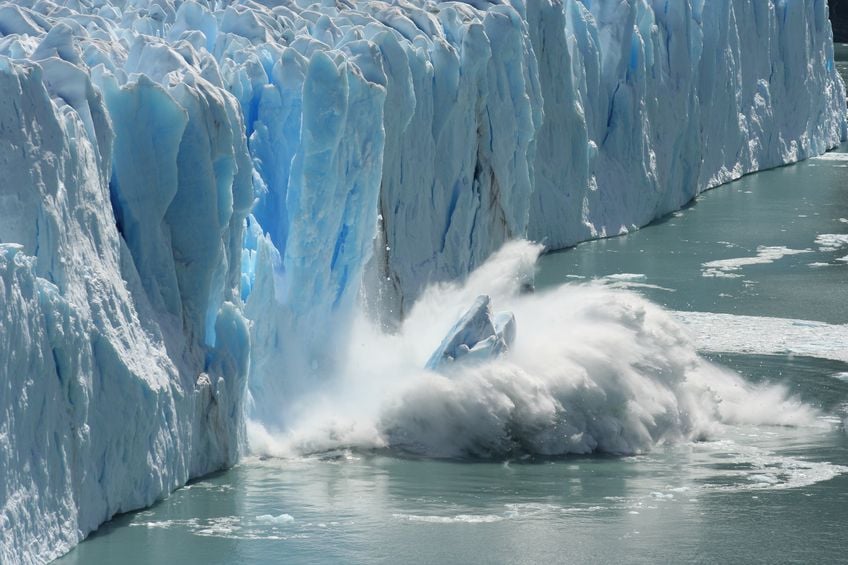If you’ve ever stood at the foot of a glacier, you’ll know how magnificent and spectacular these huge bodies of ice really are. But did you know the crucial role they play in the storage of freshwater across the planet, or how much they can tell us about the impact that humans are having upon the global climate? Whether your knowledge about glaciology and glaciation is as expansive as a Patagonian glacier or the size of a humble ice cube, we’ve put together these ten facts about glaciers to introduce you to why they’re a hugely important part of our natural environment.
1. They’re essential for storing freshwater
Covering around 10% of the earth’s surface – or 5.8 million sq.-miles (15 million km²) – glaciers are far more important than most people realize. They contain roughly 75% of the world’s freshwater supply – so it’s a pretty big deal that an estimated 90% of glaciers worldwide are melting.
2. And have been on earth for millions of years
 One of the most impressive facts about glaciers is their age. The Antarctic Ice Sheet is estimated by scientists to be at least 30 million years old, while the Greenland Ice Sheet is a relative newcomer at only 2.5 million years old.
One of the most impressive facts about glaciers is their age. The Antarctic Ice Sheet is estimated by scientists to be at least 30 million years old, while the Greenland Ice Sheet is a relative newcomer at only 2.5 million years old.
3. Glaciers are mostly found at the Poles
The Arctic and Antarctic are where 99% of all glacial ice is located. That said, the Greenland Ice Sheet covers 660 sq.-miles (1,710,000km²) – about 80% of the surface of Greenland. Chile also boasts a fairly sizeable collection of glaciers, being home to 31,000 – over 80% of all those located in South America.
4. They’ve formed over hundreds of years
Forming a glacier is a painfully slow process that takes place over a period of hundreds of years. It starts with build up of snow that doesn’t melt and, with further snowfall, the weight of the accumulation begins to compress the snow, packing it down forcefully onto itself. The pressure eventually turns the snow into very dense ice where practically all of the air bubbles have been squeezed out.
5. They look blue for a reason
 Because of how dense glacier ice becomes, it looks a lot different than the ice we normally see in ice cubes or our freezers. Glaciers act like a filter and absorb red and yellow light but reflect blue, which explains why they seem to be blue in color. Older sections of glacial ice are even denser and appear even darker in color.
Because of how dense glacier ice becomes, it looks a lot different than the ice we normally see in ice cubes or our freezers. Glaciers act like a filter and absorb red and yellow light but reflect blue, which explains why they seem to be blue in color. Older sections of glacial ice are even denser and appear even darker in color.
6. And can be huge in size
The largest glacier on the planet, Lambert Glacier, is an enormous 60-miles (96 km) wide and 270-miles (435 km) long and found in Antarctica.
7. Glaciers can shape whole landscapes
The sheer weight of the ice in a glacier is what causes it to start moving down the mountain. As they do, they erode the terrain beneath them, plucking away at the bedrock beneath as well as acting like sandpaper as they abrade and smooth as well. This results in V-shaped mountain valleys transforming into deepened U-shaped valleys – the first clue that proves a region has been altered by glaciation.
8. Patagonia has seen the impact of glaciation
The emblematic torres of Torres del Paine National Park represent just just one of the many Patagonian landscapes that have been shaped by glacial forces. Indeed, the Patagonian Ice Sheet that once covered the southern Andes was responsible for forming much of the glacial landscapes that can be identified in Patagonia today.
The remains of this epic sheet of ice exist in the Northern and Southern Patagonian Ice Fields that feed into famous glaciers such as Perito Moreno in Argentina and Pía Glacier in Chile.
9. They’re very sensitive to climate change


 Although most people are aware of how worryingly quickly glaciers have been melting over the past hundred years, between the 17th- and 19th-centuries, the planet experienced a “Little Ice Age”. During this time, glaciers actually were able to advance and grow thanks to a prolonged period of cooler temperatures.
Although most people are aware of how worryingly quickly glaciers have been melting over the past hundred years, between the 17th- and 19th-centuries, the planet experienced a “Little Ice Age”. During this time, glaciers actually were able to advance and grow thanks to a prolonged period of cooler temperatures.
10. One of the most important facts about glaciers is the impact they could have upon the planet
Unfortunately, if all the land ice on the planet were to melt, worldwide sea levels would rise by 230 ft. (70m) – about the same height as a 30-story building.
This would have a profound effect upon which parts of the earth are habitable, as well as dramatically altering global temperatures. This proves why trying to reduce the speed of melting in glaciers is important to the planet as a whole and is being actively pursued by scientists across the globe.
No comments yet
There are no comments on this post yet.





Leave a comment